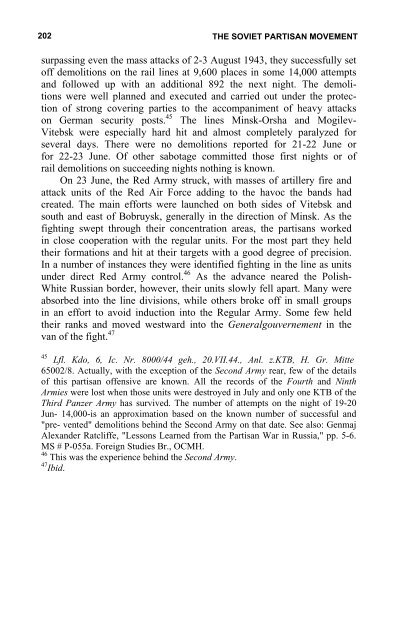the soviet partisan movement 1941-1944 by edgar m. howell
the soviet partisan movement 1941-1944 by edgar m. howell
the soviet partisan movement 1941-1944 by edgar m. howell
You also want an ePaper? Increase the reach of your titles
YUMPU automatically turns print PDFs into web optimized ePapers that Google loves.
202 THE SOVIET PARTISAN MOVEMENT<br />
surpassing even <strong>the</strong> mass attacks of 2-3 August 1943, <strong>the</strong>y successfully set<br />
off demolitions on <strong>the</strong> rail lines at 9,600 places in some 14,000 attempts<br />
and followed up with an additional 892 <strong>the</strong> next night. The demolitions<br />
were well planned and executed and carried out under <strong>the</strong> protection<br />
of strong covering parties to <strong>the</strong> accompaniment of heavy attacks<br />
on German security posts. 45 The lines Minsk-Orsha and Mogilev-<br />
Vitebsk were especially hard hit and almost completely paralyzed for<br />
several days. There were no demolitions reported for 21-22 June or<br />
for 22-23 June. Of o<strong>the</strong>r sabotage committed those first nights or of<br />
rail demolitions on succeeding nights nothing is known.<br />
On 23 June, <strong>the</strong> Red Army struck, with masses of artillery fire and<br />
attack units of <strong>the</strong> Red Air Force adding to <strong>the</strong> havoc <strong>the</strong> bands had<br />
created. The main efforts were launched on both sides of Vitebsk and<br />
south and east of Bobruysk, generally in <strong>the</strong> direction of Minsk. As <strong>the</strong><br />
fighting swept through <strong>the</strong>ir concentration areas, <strong>the</strong> <strong>partisan</strong>s worked<br />
in close cooperation with <strong>the</strong> regular units. For <strong>the</strong> most part <strong>the</strong>y held<br />
<strong>the</strong>ir formations and hit at <strong>the</strong>ir targets with a good degree of precision.<br />
In a number of instances <strong>the</strong>y were identified fighting in <strong>the</strong> line as units<br />
under direct Red Army control. 46 As <strong>the</strong> advance neared <strong>the</strong> Polish-<br />
White Russian border, however, <strong>the</strong>ir units slowly fell apart. Many were<br />
absorbed into <strong>the</strong> line divisions, while o<strong>the</strong>rs broke off in small groups<br />
in an effort to avoid induction into <strong>the</strong> Regular Army. Some few held<br />
<strong>the</strong>ir ranks and moved westward into <strong>the</strong> Generalgouvernement in <strong>the</strong><br />
van of <strong>the</strong> fight. 47<br />
45<br />
Lfl. Kdo, 6, Ic. Nr. 8000/44 geh., 20.VII.44., Anl. z.KTB, H. Gr. Mitte<br />
65002/8. Actually, with <strong>the</strong> exception of <strong>the</strong> Second Army rear, few of <strong>the</strong> details<br />
of this <strong>partisan</strong> offensive are known. All <strong>the</strong> records of <strong>the</strong> Fourth and Ninth<br />
Armies were lost when those units were destroyed in July and only one KTB of <strong>the</strong><br />
Third Panzer Army has survived. The number of attempts on <strong>the</strong> night of 19-20<br />
Jun- 14,000-is an approximation based on <strong>the</strong> known number of successful and<br />
"pre- vented" demolitions behind <strong>the</strong> Second Army on that date. See also: Genmaj<br />
Alexander Ratcliffe, "Lessons Learned from <strong>the</strong> Partisan War in Russia," pp. 5-6.<br />
MS # P-055a. Foreign Studies Br., OCMH.<br />
46 This was <strong>the</strong> experience behind <strong>the</strong> Second Army.<br />
47 Ibid.
















